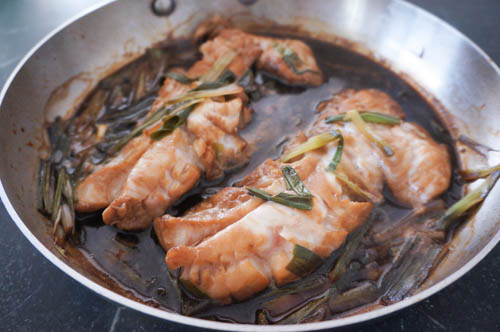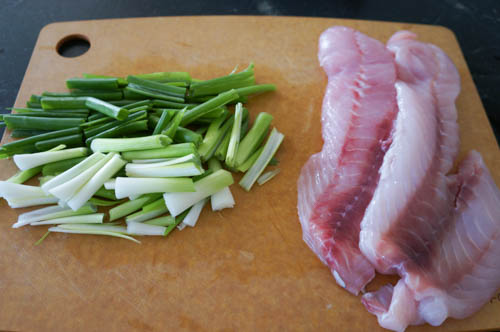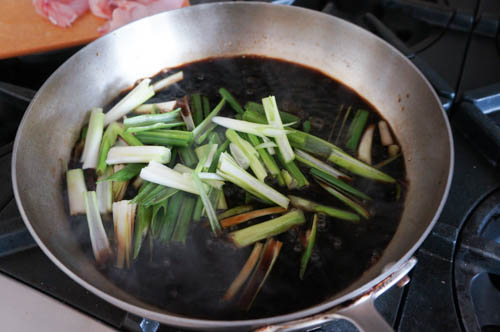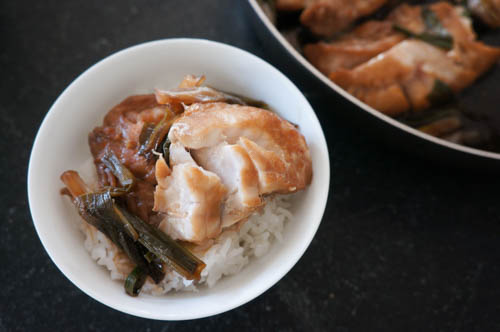It always seems intimidating to go out and buy fish, but a year or so ago I signed up for a local CSS (community supported seafood) program that brings the fish to me. It’s like a CSA (community supported agriculture) but instead of seasonal produce from local farmers, I get the catch of the week from local fishers.
Each week I dig into my soft cooler bag of crushed ice and pull out ziploc of filleted fish, more often than not something I’ve never heard of – rockfish, grenadier, sand sole, ling cod – and figure out how to cook it. If it’s salmon, I always make sweetly glazed salmon teriyaki. But for most white fish, this recipe, adapted from Mark Bittman, is one of the easiest and best.
Fish fillets take a short dip in a skillet bubbling with soy sauce, wine (or water) and a bit of sugar. The fish cooks up tender and succulent, with plenty of sauce to spoon over rice. So simple. And it works well with all kinds of fish.
I’ve learned to be less hung up on names of fish – there are so many, and even the same fish can go by different handles – and more focused on whether or not the fish is wild or farmed. Farmed fish raised on corn or soy pellets is no better for you than industrial chicken or beef. To get the health benefits we associate with fish (a new study finds that fish eaters even have bigger brains), you need fish that feed from the phytoplankton-zooplankton food chain.
These days it’s not hard to find great quality wild-caught fish in individually frozen fillets. Fish defrosts quickly when submerged in cold water (you can leave it in plastic if it’s shrink-wrapped), and then it’s ready for cooking.
I’m lucky to have fish come from nearby Santa Cruz. Husband Hans catches the fish or sources it from the fishing community, while wife Heidi manages the subscriber base and delivery logistics. Drivers drop the bags of fish in large coolers outside homes in various towns in the area, and subscribers pick up from their local drop spot.
Aside from fillets of white fish, all you need for this minimalist recipe are scallions and good quality soy sauce. Because there are so few ingredients, this recipe relies on quality soy sauce. I always use Kikkoman, which is widely available.
Put some rice on to cook first. This method is so fast, even with prep time the fish takes less time to cook than rice.
I use sake or white wine to dilute the soy sauce, but Bittman just uses water, which works well too. Heat the sauce, followed by the scallions.
Then fish.
Keep it at a lively simmer, flipping the fish over as it cooks.
The sauce reduces nicely as the fish cooks.
And that’s all there is to it. Spoon some fish and scallions over the rice, followed by plenty of sauce. Aren’t you feeling smarter already?
(Kentucky Derby anyone? I have a great derby pie recipe in case anyone needs one this weekend. It’s actually a Christmas tradition in our family, but I should make it in May too. Once a year isn’t enough for this chocolatey, nutty, boozy treat.)
Soy Sauce Poached Fish
This recipe delivers so much for so little work – fish fillets cooked for a few minutes in a skillet with soy sauce, wine (or water) and a bit of sugar. The fish cooks up tender and succulent, with plenty of sauce to spoon over rice. Adapted from Mark Bittman.
Ingredients
- 1/3 to 1/2 cup good soy sauce (I use Kikkoman)
- 1/2 to 2/3 cup sake (or white wine, or water)
- 1 tablespoon sugar
- 1-2 bunches scallions, trimmed and cut into 2-inch lengths (or 1 onion, peeled and sliced)
- 1 dried or fresh chili, optional
- About 1 1/2 pounds mild white fish fillets (eg striped bass, grouper, halibut, cod; skin-on or not)
Preparation
- Combine the soy sauce, sake (or water), sugar, scallions and chili in a skillet just large enough to hold the fish. Turn the heat to medium high, and bring to a boil.
- Add the fish, and adjust the heat so the mixture bubbles but not furiously. Cook a few minutes per side, turning once or twice, until the fish is coated with a brown glaze and cooked through (the flesh gives in when you poke it instead of resisting). Serve with white rice, spooning the sauce over and garnishing with the scallions.
Serves 4.
Notes
- Bittman recommends striped bass, but I’ve used this recipe for all kinds of fish. Poaching leaves everything tender and delicious, but I like this best with flaky, mild white fish. Stronger-flavored fish, like salmon, can take a more intensely-flavored sauce, like teriyaki.
- It’s best to store fish sandwiched in ice or freezer packs in your refrigerator (fish is best kept between 32 and 34 degrees F, and your fridge is likely 36-40 degrees F).
- Frozen fish defrosts quickly when submerged in cold water (you can leave it in plastic if it’s shrink-wrapped), and then it’s ready for cooking.
- Because there are so few ingredients, this recipe relies on quality soy sauce. I always use Kikkoman, which is widely available.
- Feel free to play with this adaptable recipe: add fresh ginger or garlic; adjust the sweetness or the heat.
Here’s the link to a printable version.











Everyone loved it! Told the kids it was “white salmon” and Lola gobbled it down! Perfection! Adding it to the rotation! Thanks!
Amazing! Thank you so much, this looks delish. I love your blog. SO glad you shared!
I learned to make a similar fish from a Taiwanese friend years ago. The only real difference is sprinkle a generous amount of roughly chopped cilantro onto the fish before pouring a little of the cooking sauce over. Yum!
Hi CG! I am a newbie to your blog, but I love it! This recipe was fantastic 🙂
I made it using a fish called Creamy Dory (no, not THAT Dory!), which upon further investigation, I found to be a type of Mekong River catfish. The sauce and leeks were incredible, but I think the flavor was a little off on the fish. I bet if I had used a fish from the ocean (or maybe not a bottom dweller…) it may have turned out better. Any thoughts on this?
hi genevieve – welcome to the blog, so glad you found me! fish is so local, it’s hard to say what might be the issue. maybe check out this article on cream dory – some people say the mekong river is really polluted so that may impact the taste of the fish. very happy you enjoyed the recipe – hopefully you are even more successful with another fish next time.
Thank you for your reply and the article. I’d better do more research before buying mystery fish!
This is a really good and easy fish dish. Now I can make fish a lot more often.
hi helen – so glad u like it! i love how easy it is too. 🙂
Can’t wait to try this simple recipe, especially as it is quick and simple and allows for your own additions and variations. I was wondering if there was any oil used in the recipe?
hi dana w – no oil needed! i hope you like it…is is such a great payoff for so little effort. 🙂